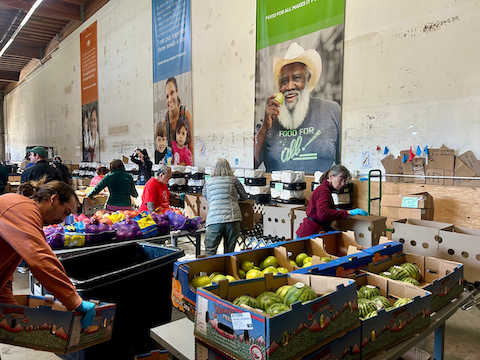05 Mar Grassroots Anti-Violence Efforts Starting to Bear Fruit in Richmond
News Report, Monica Quesada
Richmond, long burdened by the reputation of being one of the Bay Area’s most dangerous cities, experienced an overall decrease in violent crime last year, according to data recently made public by the city’s police department.
Overall, violent crime decreased 14 percent citywide between 2010 and 2011, according to Richmond Police Department statistics from last January obtained by The CC Pulse. Those crimes include armed carjacking (down 30 percent), attempted homicide (down 14 percent) and attempted robbery (down 65 percent). Also down were the number of drug-related 911 calls (down 46 percent), “man with gun” calls (down 18 percent) and reports of “neighborhood gunfire” (down 13 percent).
Nicole Valentino, a community-advocate at the Richmond mayor’s office, says it is a mix of resident groups and non-profit organizations that are making the difference.
“The story of Richmond is more and more (about) people coming together to make things better,” says Valentino.
Those deeply involved in the anti-violence work, she adds, come from an array of backgrounds. Some are from places outside of Richmond who have nevertheless fully committed themselves to the community, while others are Richmond locals who have always had the talent and desire to be neighborhood leaders, but perhaps not the training to be effective. Then there are those who left Richmond to get a college degree and decided to come back to improve their city. Together, says Valentino, their efforts are beginning to have a noticeable impact.
Not all violent crimes in Richmond, however, have gone down. Most troubling, the number of criminal homicides rose from 21 deaths in 2010 to 26 in 2011. The rise in homicides in Richmond and other Bay Area cities was even the subject of a report in The Wall Street Journal last September.Certain property crimes also increased — residential burglary and car break-ins were both up by about 15 percent from the previous year.
Police and neighborhood activists in Richmond, however, now have a reason to be optimistic that those numbers too can be reduced through a coordinated combination of law enforcement and community support for the city’s most troubled youth.
In an email to community stakeholders that accompanied the most recent crime report, police chief Chris Magnus wrote, “We recognize… that many factors influence crime and violence in our city, but we believe that active neighborhood and community groups partnering extensively with the Police Department are a big part of the reason we are making progress towards a safer Richmond.”
One of those community groups is Ceasefire, a collaborative project that seeks to unite clergy, congregations, law enforcement and community members against gun violence in Richmond by approaching troubled youth with a message of love.
“We want to see (the youth) alive and free, but we are no longer going to tolerate being terrorized by gun violence,” said Rev. Eugene Jackson of Grace Bible Fellowship in Antioch. Jackson is also an organizer for CCISCO (Contra Costa Interfaith Supporting Community Organization), one of the organizations participating in Ceasefire.
Part of the Ceasefire strategy involves organizing weekly “night walks” in different Richmond neighborhoods, during which participants hand out information about the program and talk to residents about their needs. “We have people as old as 90 (and) as young as 8 years old,” said Jackson about the participants. “We own the streets in a way that has never been seen.”
In addition to the gun-related crimes, captain Mark Gagan says a major problem facing Richmond right now is the increase in residential burglary and auto theft. Those crimes, he says, are keeping Richmond entrenched at the bottom of city crime rankings.
Police Chief Magnus agrees. “Property crime, while very slightly down (overall), continues to be a challenge, particularly in regards to residential burglaries,” he wrote.
Gretchen Borg is a teacher at Gompers, a continuation high school in Richmond. She moved into a new house in south Richmond in September 2010, and a week later her house was broken into. “They took my computer and my punk rock CDs,” Borg says. “So you know they were kids.”
Borg believes many youth in Richmond resort to theft and burglary because of unstable family situations and the lack of jobs for the young people in the city. They’ll do whatever it takes to make money, she says, even if it means stealing.
Matthew Stonebraker, 34, was born and raised in central Richmond and after completing his service in the army, decided to come back to serve his community as a police officer. Stonebraker has been on the force now for more than five years, and says he can see the positive impact that greater community involvement is having on the city.
“When I was growing up, there would be 20 dudes on a corner selling drugs and maybe three would have guns,” Stonebraker said. “(But) today, a lot of good people are moving in and making a positive change in the city.”
Mike Rubio, youth organizing director at RYSE, a youth center that offers programs and support services to Richmond youth, says change in Richmond will come as a result of “young folks pushing [and making demands to] adults.”
The youth organizers he is training at RYSE, says Rubio, are looking at the big picture, not trying to modify individual behaviors but looking at the root causes of violence and crime and identifying the policies and programs that will impact as many people as possible.
“They see themselves as agents of change,” says Rubio.
Mayor Gayle McLaughlin also believes the solution to Richmond’s violence lies in addressing the root causes, as opposed to suppressing the symptoms. “Ultimately, we have to resolve poverty in general, issues of equality and justice for all,” she said. “That is going to be the real solution for really bringing about a full, healthy and safe Richmond.”
Taisa Grant, 26, came to Richmond when she was 5, and left to attend college. Although she no longer lives in the city, Grant stays involved in the community, including as a regular contributor to The CC Pulse.
“I was kind of scared to come back after college, because people I graduated with had been killed,” she says. In spite of that, Grant has maintained a positive perception of her hometown.
“Richmond has beautiful, raw, talented, unnoticed, community oriented, empowered people,” says Grant. “The violence hurts you, but you have to get over it, and it’s not going to stop me from making a change.”






No Comments